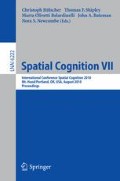Abstract
People can experience an environment in different ways and from different points of view: by moving around in it, inspecting it from above (flying, viewing from a mountain top or high building), studying a map, or listening to a verbal description. How an environment is experienced can influence its spatial representation and, as a consequence, spatial performance. However, this latter can also be influenced by a series of factors inherent to individuals: gender, spatial and working memory abilities, cognitive styles in spatial representation, motivation and attitude toward spatial tasks, emotion and personality. Here I present an overview of a series of research programs underway in the Laboratory of Learning and Memory at the University of Paduas Department of General Psychology. Our research on spatial cognition has focused on two main topics: (i) memory and comprehension of spatial language, (ii) navigation and way-finding behavior. In both cases, particular emphasis has been given to the study of individual differences. Spatial text comprehension and navigation vary widely among individuals. We investigated potential sources of individual differences and examined the roles of spatial ability, working memory, cognitive style in spatial representation, as well as those of other non-cognitive variables: motivation, personality and emotion. To measure individual differences in sense of direction (SOD), cognitive styles in spatial representation, motivation in performing spatial tasks, and spatial anxiety, we constructed a number of self-rate scales, which are illustrated in terms of performance on various spatial tasks.
Access this chapter
Tax calculation will be finalised at checkout
Purchases are for personal use only
References
Caprara, G.V., Barbaranelli, C., Borgogni, L.: Big Five Questionnaire. Organizzazioni Speciali, Florence, Italy (2000)
De Beni, R., Pazzaglia, F., Gyselinck, V., Meneghetti, C.: Visuo-spatial working memory and mental representation of spatial descriptions. European Journal of Cognitive Psychology 17, 77–95 (2005)
Denis, M., Pazzaglia, F., Cornoldi, C., Bertolo, L.: Spatial discourse and navigation: An analysis of route directions in the city of Venice. Applied Cognitive Psychology 13, 145–174 (1999)
Gyselinck, V., Meneghetti, C., De Beni, R., Pazzaglia, F.: The role of working memory in spatial text processing: What benefit of imagery strategy and visuospatial abilities? Learning and Individual Differences 19, 12–20 (2009)
Jreskog, K.G., Srbom, D.: LISREL 8: Users reference guide. Scientific Software International, Chicago (1996)
Pazzaglia, F., De Beni, R., Meneghetti, C.: The effects of verbal and spatial interference in the encoding and retrieval of spatial and nonspatial texts. Psychological Research 71(4), 484–494 (2007)
Pazzaglia, F., Taylor, H.A.: Perspective, Instruction, and Cognitive Style in Spatial Representation of a Virtual Environment. Spatial Cognition & Computation 7(4), 349–364 (2007)
Perrig, W., Kintsch, W.: Prepositional and situational representations of text. Journal of Memory and Language 24, 503–518 (1985)
Taylor, H.A., Tversky, B.: Spatial mental models derived from survey and route descriptions. Journal of Memory and Language 31, 261–292 (1992)
Author information
Authors and Affiliations
Editor information
Editors and Affiliations
Rights and permissions
Copyright information
© 2010 Springer-Verlag Berlin Heidelberg
About this paper
Cite this paper
Pazzaglia, F., Meneghetti, C. (2010). Individual Differences in Spatial Language and Way-Finding: The Role of Cognition, Emotion and Motivation. In: Hölscher, C., Shipley, T.F., Olivetti Belardinelli, M., Bateman, J.A., Newcombe, N.S. (eds) Spatial Cognition VII. Spatial Cognition 2010. Lecture Notes in Computer Science(), vol 6222. Springer, Berlin, Heidelberg. https://doi.org/10.1007/978-3-642-14749-4_1
Download citation
DOI: https://doi.org/10.1007/978-3-642-14749-4_1
Publisher Name: Springer, Berlin, Heidelberg
Print ISBN: 978-3-642-14748-7
Online ISBN: 978-3-642-14749-4
eBook Packages: Computer ScienceComputer Science (R0)

